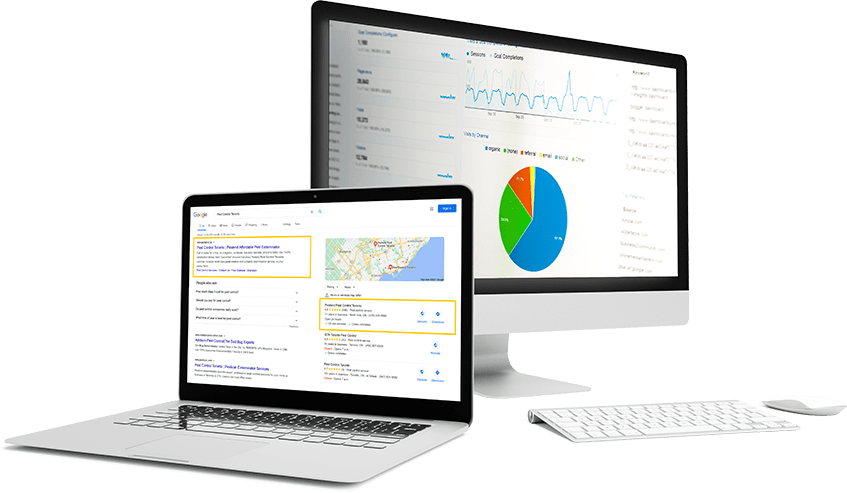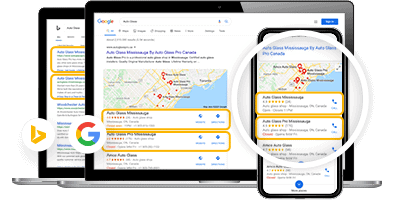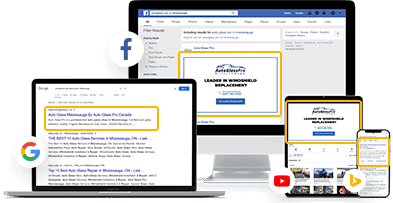
For better rankings on Google and Bing, having a long tail keyword strategy is essential
Long tail keywords are longer, more specific phrases searched by users. Common examples of long tail keywords include adding a location, category, or details such as “Search Engine Optimization in Toronto” or “Long Tail Keyword SEO in Mississauga” In fact, Wordstream reported in 2016 that 50% of search queries are four words or longer.
Including long tail keywords in your search engine optimization strategy can yield greater results, in the form of website traffic, overall rankings, and ultimately, sales.
Why Should You Use Long Tail Keywords?
Long tail keywords are a pivotal part of any search engine optimization strategy, for a few reasons.
Less Competitive & More Affordable
Long tail keywords make up 70% of the total search traffic online. As a result, these terms have less competition when compared to more popular terms, which account for the remaining 30% of traffic. While it is beneficial to rank for generic, popular keywords such as “web design,” “SEO,” or “Search Engine Optimization,” it’s almost impossible for small businesses to do so efficiently because of their limited budget and strong global competition.
For instance, if you sell window blinds, it will take a lot of effort to rank for the keyword “blinds” as it has over 148,000,000 results on Google. However, targeting long tail keywords such as “motorized blinds” or “curtain track systems” which have less online competition will take less effort and will still attract customers.
Considering 75% of all search result clicks go to websites ranked on the first page, we use our long-tail keyword SEO strategy to have your business ranking on page one of Google and Bing for relevant keywords while staying within your limited budget.


Reach the Right Audience
When we search online, we either know what we’re looking for or we don’t. When we search for information and research, we’ll use plain keywords. As we go further into the process and learn more about the product/service, we’ll use long tail keywords for more specific queries. For marketers, long tail keyword searches indicate that a user is likely near the end of a buying cycle.
For example, if someone searches for “curtain rods,” they are likely not committed to a specific brand or style. On the other hand, if a user searches for “iron curtain rods for sale in Ontario” or “bay window curtain rods on sale,” they know exactly what they want and are more likely to buy.
With this in mind, it’s easy to see why long tail keywords are an essential part of effective SEO. When you combine the higher rankings due to lower competition and the buying intent of the searcher, it logically leads to more sales for your business.
Hear What Our Customers Are Saying About Our Long Tail Keyword Research Services
Dr. Mansour Yasser
Alliance For Just Money Executive Committee, staff, and Board
Caroline Muir
ZAID
Higher Conversions
Since you’ve used long tail keywords to leverage less competition and capture your audience later in the buying cycle, you’re more likely to see higher conversion rates from your search rankings. Higher conversions drive more traffic to your website, which leads to more paying customers.
Plus, if your online marketing strategy includes pay-per-click (PPC) advertising in search engines, the combination of low competition and the purchase cycle also leads to a lower cost-per-click (CPC). A low CPC plus a high conversion rate equals a larger return on investment for your business.


How to Find Long Tail Keywords
For the best search engine optimization results, we need to identify which long tail keywords to target. In order to do so, we need to conduct strategic keyword research. Instead of assuming what your audience searches for and blindly creating content around these keywords, we use the following tactics:
Predictive Search
Go to Google, Bing, or DuckDuckGo and start searching. As you type, you’ll notice suggestions related to your search. This predictive search function provides you with insights into what users are searching for with relation to your search query.
For example, if you begin to type “best seo” the following long tail keywords may appear:
-
best SEO companies in Toronto
-
Best SEO company
-
Best SEO Toronto
-
Best SEO practices
We use these predictive searches to target related long tail keywords within your SEO strategy.


Google Keyword Planner
Another popular keyword tool used by search engine marketers is the Google Keyword Planner. This tool shows us search volumes, frequency, and other data related to specific keywords. Some other keyword tools we use include but are not limited to:
-
Keyword Research Tool from WordStream
-
Related Search Suggestions in Google
-
Moz Keyword Explorer
How to Use Long Tail Keywords in Your SEO Strategy
Identifying long tail keywords and ranking for them on top of search engines are two separate feats. These keywords must be strategically placed throughout your website in places such as:
-
Headlines
-
Page Titles
-
Meta Tags
-
URLs
-
Blog Content
-
Page Content
-
Alt Tags
-
Image Names
-
File Names
-
Videos


And that’s only a part of it!
Considering that 99% of the top ranked sites on the first page of search results used meta descriptions and 80% used H1 tags in their content, your long tail keywords will stand out to users searching for specific answers and/or content.
Your keywords must be properly woven into the content and back-end of your website, not placed haphazardly – see the previous example of “motorized blinds” and “curtain track systems.”
On top of all this, there is an off-page component that is essential to have you ranking high on page one of Google and Bing for long-tail keywords.
This is Where Our SEO Services Come Handy
At Wisevu our search engine optimization professionals have an in-depth knowledge of how to find, target, and leverage long tail keywords to generate the maximum return on your investment.
Ready to take advantage of all the benefits long tail keywords have to offer? Contact the experts at Wisevu.

I have been with Wisevu since 2011 and they are amazing, onset and they have the best customer service, I recommend them to all people who want to grow their business with search engine optimization and web development.
Outstanding results and customers service.! Wisevu, YOU have been a big part of our success for the last few years. Thank you Wisevu team!!
Worldclass. The team at WiseVu is always very responsive and competent, and they are capable of performing everything ranging from SEO & SEM to website design and development at the highest caliber around.
Meet The Wisevu Team
Get to know the people that make it all possible, from our business strategists to our content developers, web designers, web developers, search engine and social media experts, and more.
Darko D.
Chief Executive Officer
Business Strategy & SEO Lead
Darko D.
Darko is a business consultant and search engine algorithm expert with over 15 years of experience. His education is in computer science, search engine algorithm analysis, and business marketing. His passion is helping organizations that are involved in activities that contribute to the betterment of our communities and our planet succeed on the web.
Drazen D.
Chief Operating Officer
Business Strategy & Web Development Lead
Drazen D.
Drazen is a web dev business strategist responsible for overseeing the website development strategy and implementation for clients. As a team lead for Wisevu's web development, UI/UX and online reputation teams, Drazen is here to revolutionize digital marketing. "The revolution will be digitized;)"
Ilya C.
Software Automation Engineer
Integration Solutions Architect
Ilya C.
Experienced in software automation and system integrations, Ilya designs and implements seamless solutions, bridging diverse platforms. With deep technical acumen, Ilya ensures efficient and error-free data flow across various IT environments, optimizing business processes.
Vanessa B.
Content & Outreach Specialist
BSc Biology & Cosmetic Science
Vanessa B.
Vanessa is a Digital PR and Medical Content Editor. She has excellent research and communication skills and is able to personalize communications to individual journalists, bloggers and webmasters which results in top-quality online publications and backlinks.
Vanessa loves all things Content since she knows Content is King!
Ida F.
Outreach & Digital PR Manager
SEO Outreach & Digital PR
Ida F.
As a part of the Wisevu SEO outreach management team, Ida specializes in strategising, managing and overseeing the success of all digital outreach and link building campaigns. Ida loves utilizing cutting edge enterprise outreach software which helps her to oversee and automate many large outreach & Digital PR campaigns. Ida loves working with her team every day and ensuring projects are completed to the highest Wisevu standards, as well as to ensure her teammates are motivated and having fun doing their very important jobs.
Deana K.
Outreach & Digital PR Specialist
SEO Link Building
Deana K.
As a part of the Wisevu SEO outreach team, Deana specializes in implementing highly strategic digital outreach and link building campaigns which drive real SEO results. Deana loves using industry leading outreach software at Wisevu which help her to stay organized and to automate many of the time consuming responsibilities required when managing multiple outreach campaigns at once. Deana takes great pride in establishing some of the highest quality and most relevant backlinks in the industry for our valuable clients.
Carolina M.
Accounts Manager
Client & Team Management
Carolina M.
With over 10 years of experience in digital marketing, Carolina is an expert in client and team management. She has worked at top global agencies, leading successful campaigns for high-profile clients across various industries. Known for her strategic mindset and leadership skills, she consistently delivers impactful, results-driven marketing solutions.
Michael V.
Team Manager
MBA in Communications
Michael V.
With a deep understanding of team management, Michael ensures teams operate at peak efficiency. His master's degree in communications has taught him to foster exceptional team cohesion and effective communication.
Francis I.
Digital PR Specialist
SEO & Outreach
Francis I.
Francis is a Digital PR and SEO specialist. He is an expert at using industry-leading outreach software in order to land clients in highly reputable online publications. Francis is really skilled at implementing world class Digital PR campaigns that result in rapid SEO ranking improvements.
Raj K.
SEO Project Manager
B. Com & MBA in Marketing
Raj K.
Raj is the lead SEO Project Manager at Wisevu, responsible for launching technical SEO campaigns as well as the overall performance of clients' SEO campaigns. He has a Master's degree in Marketing and is highly skilled in performing technical SEO audits as well as implementing and analyzing advanced analytics/conversion tracking.
Adrian A.
SEO Specialist
BSBA in Marketing
Adrian Araneta
Adrian is a results-oriented Google Analytics Certified SEO specialist who continuously strives to improve website performance and visibility. With a meticulous approach to optimization and a commitment to ongoing learning, he works diligently to deliver organic growth and help clients achieve their online goals.
Jay R.
SEO Specialist
BSBA in Marketing
Jay Raturi
Jay Raturi, the SEO Specialist brings expertise to strategic SEO campaigns. With a passion for enhancing online presence, this professional employs technical prowess and advanced analytics skills to optimize websites for peak performance.
Matthew A.
SEO Specialist
BSBA in Marketing
Matthew A.
Matthew is a passionate and highly experienced technical SEO specialist with meticulous attention to detail. He excels at optimizing all technical components of SEO and is dedicated to keeping them in peak condition. Matthew thrives on understanding the intricacies of ever-evolving SEO algorithms and implementing advanced tactics to ensure world-class, long-term results.
Anu B.
Paid Marketing Specialist
Social Media & Content Strategist
Anu B.
Anu is passionate about increasing the ROI for clients' paid marketing efforts. She is a T-shaped marketer who understands the nuances of digital marketing and has an extensive understanding of content, copy, and design. Her expertise is in Google and Bing paid Ads, Facebook and Instagram to name a few.
Hans J.
Junior SEO Specialist
BBA in Marketing
Hans J.
Hans is a result-driven SEO specialist with a proven track record of optimizing websites for search engines and driving organic traffic with a holistic SEO approach. He is proficient in in-depth semantic keyword research and ensures content is optimized for search intent and high traffic.
Barbara G.
Senior Conversion Copywriter
B.A. in Journalism
Barbara Gutierrez
Barbara is a content writer with over three years of experience. Her work has been published in international publications and has created case studies about institutional companies. She always writes with the audience in mind and believes that creating a copy that the audience can easily understand is her top priority.
Lafuma S.
Senior Conversion Copywriter
Master, English Language and Literature
Lafuma S.
Lafuma is a passionate copywriter with years of experience in the field of content marketing. She has always had a love for words and language. Lafuma enjoys writing content that speaks directly to the needs of the customer and as Einstein said, simplifying everything so it is as simple as possible but not any simpler.
Harvey T.
Senior Conversion Copywriter
B.A. in Mass Communication
Harvey T.
Harvey is a passionate writer who excels at connecting with diverse audiences, tailoring his writing to engage and drive results. He focuses on delivering clear, impactful content that informs, inspires, and motivates action, helping businesses succeed through the power of well-crafted words.
Aldrin S.
SEO Specialist
BS in Computer Science
Aldrin S.
Aldrin is a results-driven SEO specialist who utilizes in-depth research and data analysis to develop strategies focused on delivering measurable business results. He specializes in technical SEO and online authority development, ensuring that campaigns deliver long-term success.
Maria P.
Content Developer
Direct Response Copywriter
Maria P.
Maria is a content writer with a background in media communications, rooted in journalism. With a keen eye for detail, she writes compelling web copy for Wisevu's clients, helping them achieve their business goals through impactful and persuasive writing.
Jason S.
Senior UI/UX Designer
Branding and Web Graphics
Jason S.
Creative and detail-oriented UI/UX Designer passionate about crafting intuitive, user-centered digital experiences. Skilled in wireframing, prototyping, and creating visually compelling designs that enhance usability and engagement
Amber R.
Senior Website Designer
Branding and Web Graphics
Amber R.
Amber is a senior digital designer and illustrator with over a decade of experience. With a passion for aesthetics, detail and new trends, her work is known for its thoughtfulness, creativity and warmth. She believes that with kindness and a splash of design, we can engage fresh new narratives into the world.
Annica M.
Senior Website Designer
Branding and Web Graphics
Annica M.
Annica is a multimedia graphic designer, specializing in UX/UI website design. She is driven by a passion for art and technology, and their synergy in the modern day. Despite her youth, Annica demonstrates commitment to the pursuit of knowledge and innovation, always striving to expand her horizon and go beyond expectations.
Alejandro D.
Senior Graphic Designer
Graphic & Web Design
Alejandro D.
A graphic designer with more than 15 years of experience working with major brands such as City Bank, McDonalds, Telmex, and many more.
With extensive skills in design and communications, Ale is able to deliver results beyond expectations every time.
Ahmed R.
Senior Backend Developer
Web Developer
Ahmed R.
Ahmed is a seasoned Senior Backend Developer with over 5 years of experience in creating pixel-perfect and responsive websites. His skill set includes API integrations, WordPress Plugins, Theme development, PHP, and innovative approaches to deliver advanced website solutions for clients.
Areeb M.
Senior Website Developer
Front-End Web Developer
M Areeb
Proficient and creative front end developer with a strong history in website development and management. Expert in all aspects of website development, including CMS & eCommerce platforms. Skilled in creating engaging and interactive websites.
Ajanthan
Backend Developer
WP Plugin & Web development specialist
Ajanthan
AJ is a plugin specialist with over 5+ years of experience building pixel perfect responsive websites. His expertise includes API integrations, custom WordPress development, PHP and innovative ways to offer better website solutions to clients.
Khalid M.
Senior Web Developer
WordPress Developer
Khalid M.
Detail-oriented WordPress Developer skilled in the creation of custom themes. Highly trained in web and mobile development as well as UI/UX design. Skilled in all facets of WordPress, GitHub and frontend programming languages.
Karthik K.
Front-End Web Developer
Karthik K.
Karthik is a front end web developer. He is an accomplished programmer who enjoys using his skills to contribute to the Wisevu projects and bring measurable outputs.
Frank E.
Senior Web Developer
Full-Stack WordPress Developer
Frank E.
WordPress Developer with 9 years of experience specializing in custom themes, performance optimization, and creating responsive, user-friendly websites with a focus on quality and functionality.
Charville U.
Senior Full-Stack Develope
BS in Information Technology
Charville U.
Charville is a Full-Stack developer with 7 years of experience building Mobile, Web, and Desktop Applications in the industry.
Russell T.
Human Resource Administrator/Coordinator
Russell T.
Meet Russell, our Human Resource Administrator/Coordinator at Wisevu. She is dedicated to fostering a thriving workplace where all employees are happy and productive, while also ensuring that Wisevu is staffed with the most talented employees from across the globe.
Areas of Expertise

Custom Website Development
We develop lightning fast websites on WordPress, the World’s #1 website platform. Our sites are impressive, fast, secure, user friendly and built to rank high on search engines.

Search Engine Optimization (SEO)
Wisevu specializes in SEO for local businesses and non-profits. We have clients in hyper-competitive industries that are ranking at the top of Google for their most important keywords.

Pay Per Click (PPC)
We develop lightning fast websites on WordPress, the World’s #1 website platform. Our sites are impressive, fast, secure, user friendly and built to rank high on search engines.
Call Now To Book A Free Appointment
Speak with an internet marketing expert about your goals and how we can help you succeed on the web.
Got a Question?

Call Now To Book A Free Appointment
Speak with an internet marketing expert about your goals and how we can take your business to the next level.

































